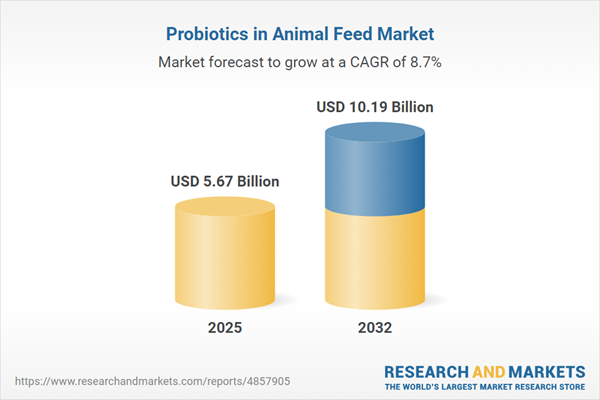Speak directly to the analyst to clarify any post sales queries you may have.
The probiotics in animal feed market is experiencing a transformation as industry leaders recalibrate strategies to align with stricter compliance requirements, shifting consumer expectations, and evolving global supply scenarios. Companies are unlocking new value through innovation while supporting operational resilience across animal nutrition sectors.
Market Snapshot: Growth Prospects for the Probiotics in Animal Feed Market
The global probiotics in animal feed market is forecast to increase from USD 5.24 billion in 2024 to USD 5.67 billion in 2025, with future outlooks reaching USD 10.19 billion by 2032. Industry directions are marked by a strategic move away from traditional antimicrobial solutions as senior decision-makers accelerate the adoption of evidence-based, advanced nutrition approaches. Key organizations are reinforcing compliance structures, prioritizing R&D investments, and optimizing production efficiency to strengthen their positions. Heightened regulatory oversight and complex supply dynamics are prompting stakeholders to adopt adaptive operations and deepen engagement with research-driven and digitally enabled processes, creating competitive advantage in animal feed innovation.
Scope & Segmentation: Advancing Capabilities in Probiotics for Animal Feed
- Animal Types: Stratified probiotic solutions are developed for aquaculture, companion animals, poultry, ruminants, and swine, supporting tailored nutrition and management protocols for each sector.
- Strain Choices: Bacillus, Bifidobacterium, Enterococcus, Lactobacillus, and Saccharomyces are selected to optimize digestion efficiency, boost immune defenses, and promote steady productivity under varying conditions.
- Product Formats: Availability includes granules, powders, liquids, gels, microencapsulated formats, and pellets, providing integration flexibility for large producers and specialized users alike.
- Applications: Feed additives, premix ingredients, and water-soluble options support adaptation across livestock and specialty markets, with growing demand for customizable delivery forms.
- Distribution Channels: Access is broadened through direct sales, partnerships with feed mills, regional collaborations, and expanding e-commerce options in established and emerging geographies.
- Regional Coverage: North America, South America, Europe, the Middle East, Africa, and Asia-Pacific are prioritized, with dynamic developments in China, India, and Southeast Asia as regulatory landscapes and consumption patterns accelerate change.
- Technology & Innovation: Deployment of genomics, bioinformatics, precision fermentation, microencapsulation, blockchain, and IoT technologies enhances traceability, optimizes quality, and supports efficient supply chain operations.
Key Takeaways: Strategic Insights for Decision-Makers
- Targeted probiotic adoption strengthens animal welfare initiatives and increases transparency throughout livestock and companion animal systems.
- Expanding product ranges and precise strain choices allow producers to keep pace with regulatory requirements and align feed strategies with stakeholder needs in disparate global regions.
- Investment in fermentation and encapsulation technology is enhancing stability and adaptability, enabling consistent performance across diverse production environments.
- Continuous monitoring of evolving regulations allows organizations to maintain compliance and improve animal health frameworks, protecting long-term market access.
- Digital solutions such as blockchain and IoT support robust procurement, enhance risk management, and improve coordination with global partners.
- Flexible manufacturing and multifaceted distribution foster agile responses to shifting demands, reinforcing trust and continuity in client relationships.
Tariff Impact: Navigating Global Sourcing Challenges
New US tariffs on microbial cultures, substrates, and packaging materials have increased sourcing costs for feed manufacturers. To sustain competitiveness and meet ongoing demand, companies are diversifying supplier portfolios and forming new agreements to distribute risk beyond singular regions. Improved logistics planning, combined with localized inventory development, is proving vital for safeguarding global supply and ensuring uninterrupted delivery to customers.
Methodology & Data Sources
This market analysis consolidates insights from animal nutrition experts, regulatory professionals, technical consultants, and logistics authorities. Data sources include reports from industry forums, peer-reviewed publications, commercial experience, and accredited providers to deliver a comprehensive and current perspective on the market.
Why This Report Matters
- In-depth segmentation and technology analysis empower executives to tailor feed strategies that address shifting market and regulatory requirements.
- Detailed channel and regional insights help proactively manage supply chain vulnerabilities and compliance complexities.
- Actionable guidance supports effective resource allocation and drives operational improvements throughout the probiotics in animal feed market.
Conclusion
Executives leveraging this report can make informed market decisions, reinforce resilience in animal nutrition initiatives, and drive innovation in probiotics for sustainable business leadership.
Additional Product Information:
- Purchase of this report includes 1 year online access with quarterly updates.
- This report can be updated on request. Please contact our Customer Experience team using the Ask a Question widget on our website.
Table of Contents
3. Executive Summary
4. Market Overview
7. Cumulative Impact of Artificial Intelligence 2025
Companies Mentioned
The companies profiled in this Probiotics in Animal Feed market report include:- Evonik Industries AG
- Archer-Daniels-Midland Company
- AB Agri Ltd.
- Adisseo France SAS
- Alltech, Inc.
- Asahi Group Holdings, Ltd.
- Cargill, Incorporated
- Charoen Pokphand Foods PCL
- DuPont de Nemours, Inc.
- Elanco Animal Health
- Kemin Industries, Inc.
- Kerry Group PLC
- Koninklijke DSM N.V.
- Lallemand Inc.
- Novozymes
- Nutreco N.V.
- Ohly GmbH
- Olmix Group
- Perdue Farms Inc.
- Phibro Animal Health Corporation
- Phileo by Lesaffre
- Provita Eurotech Limited
- Purina Mills, LLC
- VETANCO S.A.
Table Information
| Report Attribute | Details |
|---|---|
| No. of Pages | 188 |
| Published | November 2025 |
| Forecast Period | 2025 - 2032 |
| Estimated Market Value ( USD | $ 5.67 Billion |
| Forecasted Market Value ( USD | $ 10.19 Billion |
| Compound Annual Growth Rate | 8.6% |
| Regions Covered | Global |
| No. of Companies Mentioned | 25 |









